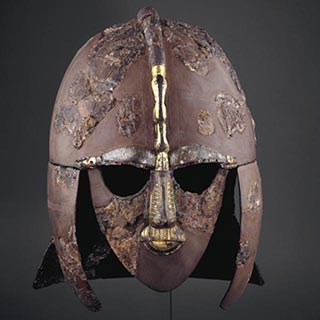Sutton Hoo

Sutton Hoo, near Woodbridge, Suffolk, is the site of an undisturbed ship burial including a wealth of Anglo-Saxon artefacts of outstanding art-historical and archaeological significance, now held in the British Museum in London.
Sutton Hoo is of a primary importance to early medieval historians because it sheds light on a period of English history that is on the margin between myth, legend and historical documentation. Use of the site culminated at a time when Rædwald, the ruler of the East Angles, held senior power among the English people and played a dynamic if ambiguous part in the establishment of Christian rulership in England; it is generally thought most likely that he is the person buried in the ship. The site has been vital in understanding the Anglo-Saxon Kingdom of East Anglia and the whole early Anglo-Saxon period.
The ship-burial, probably dating from the early 7th century and excavated in 1939, is one of the most magnificent archaeological finds in England for its size and completeness, far-reaching connections, the quality and beauty of its contents, and the profound interest of the burial ritual itself. The initial excavation was privately sponsored the landowner, but when the significance of the find became apparent, national experts took over. Subsequent archaeological campaigns, particularly in the late 1960s and late 1980s, have explored the wider site and many other individual burials. The most significant artefacts from the ship-burial, displayed in the British Museum, are those found in the burial chamber, including a suite of metalwork dress fittings in gold and gems, a ceremonial helmet, shield and sword, a lyre, and many pieces of silver plate from the Eastern Roman Empire. The ship-burial has from the time of its discovery prompted comparisons with the world described in the heroic Old English poem Beowulf, which is set in southern Sweden. It is in that region, especially at Vendel, that close archaeological parallels to the ship-burial are found, both in its general form and in details of the military equipment that the burial contains.
Although it is the ship-burial that commands the greatest attention from tourists, there is also rich historical meaning in the two separate cemeteries, their position in relation to the Deben estuary and the North Sea, and their relation to other sites in the immediate neighborhood. Of the two grave fields found at Sutton Hoo, one (the “Sutton Hoo cemetery”) had long been known to exist because it consists of a group of around 20 earthen burial mounds that rise slightly above the horizon of the hill-spur when viewed from the opposite bank. The other, called here the “new” burial ground, is situated on a second hill-spur close to the present Exhibition Hall, about 500 m upstream of the first, and was discovered and partially explored in 2000 during preparations for the construction of the hall. This also had burials under mounds, but was not known because they had long since been flattened agricultural activity. The site has a visitor’s centre, with many original and replica artefacts and a reconstruction of the ship burial chamber, and the burial field can be toured in the summer months.
